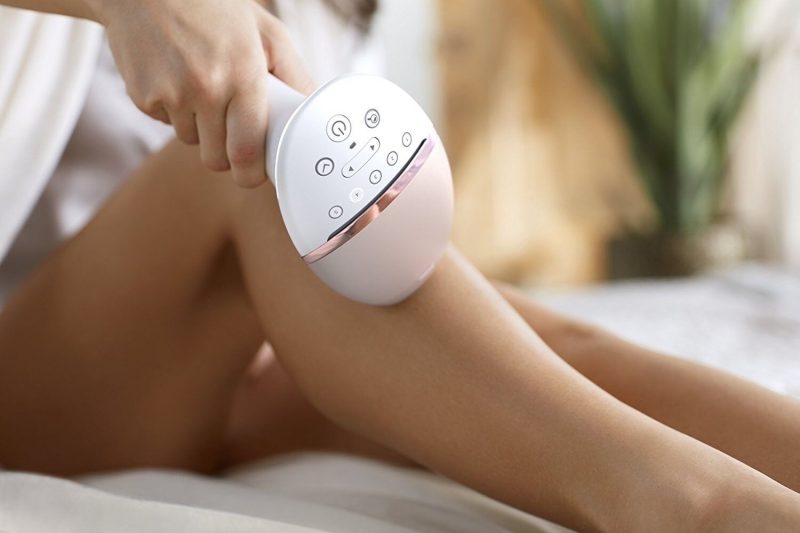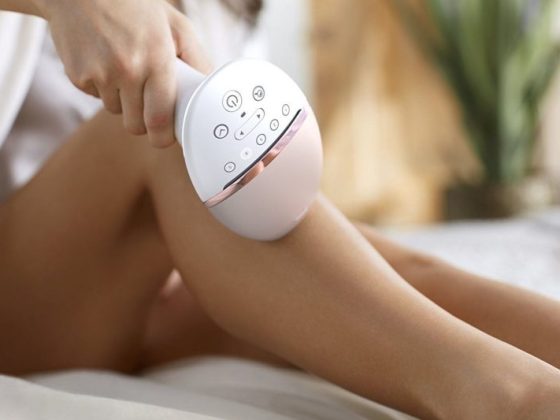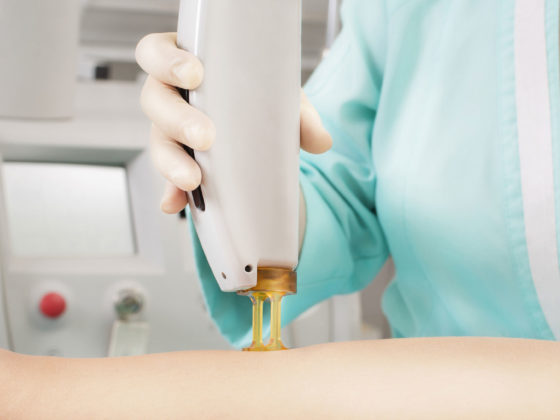Laser hair removal is a widely recognized and effective method for achieving long-term hair reduction. Our clinic often recommends it as a safe and efficient solution to unwanted hair. The procedure involves using concentrated light beams to target and damage hair follicles, inhibiting future hair growth. Over the years, it has gained popularity for its precision and lasting results.
As technology advances, at-home laser hair removal devices have become increasingly accessible. These devices aim to bring the benefits of laser hair removal into the comfort of your own home. They are designed to be user-friendly, employing similar principles to professional treatments. These devices can be effective when used appropriately, offering individuals a convenient option for managing unwanted hair between professional sessions or in the privacy of their homes. However, understanding their limitations and proper usage is crucial for achieving optimal results while prioritizing safety. This report will delve into the intricacies of at-home laser hair removal, providing valuable insights for those considering this method.
How At-Home Laser Hair Removal Works
Our clinic utilizes laser hair removal technology that targets melanin, the pigment responsible for hair color. The laser emits a concentrated beam of light that is absorbed by the melanin in the hair follicles. This absorption generates heat, effectively damaging the follicles and inhibiting future hair growth. It’s essential to note that multiple sessions are typically required to target hair in different growth phases for optimal results.
While the basic principles remain consistent, there are notable distinctions between professional and at-home laser hair removal devices. In a professional setting, devices often have higher energy levels and more precise targeting mechanisms, allowing for effective treatment across various skin and hair types. On the other hand, at-home devices are designed with user-friendliness in mind, often featuring lower energy levels to prioritize safety for individuals without professional training.
Our experience suggests that professional treatments may yield quicker results due to the expertise of trained practitioners and the advanced technology employed. At-home devices, while effective, may require more frequent use and adherence to a strict treatment schedule for comparable outcomes.
Safety is paramount in any hair removal procedure. In our clinic, we follow stringent safety protocols, and these principles extend to at-home care as well. Users must carefully follow the provided instructions for their specific device. Key considerations include skin sensitivity, potential adverse reactions, and the importance of conducting a patch test before widespread use.
It’s crucial to emphasize that individuals with certain skin conditions or those taking specific medications should consult a healthcare professional or a dermatologist before attempting at-home laser hair removal. Maintaining proper hygiene, ensuring the device is clean, and using appropriate protective measures, such as goggles, are integral aspects of providing a safe at-home experience.
Suitable Candidates for At-Home Laser Hair Removal
Skin and Hair Types

Understanding your skin and hair type is crucial for successful at-home laser hair removal. In our clinic, we consider the Fitzpatrick scale, which classifies skin into different types based on its response to sunlight. Generally, individuals with lighter skin tones and darker hair experience the most effective results. This is because the laser can more selectively target the melanin in the hair follicles.
It’s important to educate patients that while advancements have been made, at-home devices may not be as versatile as professional ones in treating a wide range of skin and hair types. Individuals with darker skin tones or lighter hair may experience varying degrees of efficacy and should manage their expectations accordingly.
Considerations for Various Body Areas

Different body areas have distinct characteristics that can influence the success of at-home laser hair removal. In our practice, we’ve observed that larger areas with coarse hair, such as the legs and back, may require more time and consistent treatment for noticeable results. Smaller, more delicate areas like the face or bikini line demand careful attention to avoid irritation.
Patients should be advised to adjust the intensity settings on their devices based on the sensitivity of the treatment area. Additionally, emphasizing the importance of precision and patience in these applications is crucial for achieving optimal outcomes.
Potential Contraindications and When to Consult a Professional
While at-home laser hair removal is generally safe, there are specific contraindications that individuals should be aware of. Our clinic adheres to a strict policy of caution for pregnant or breastfeeding individuals, as well as those with a history of keloid scarring or certain skin conditions.
Patients need to understand that if they experience any unexpected side effects, such as severe irritation, blistering, or changes in pigmentation, they should discontinue use immediately and consult a healthcare professional. Moreover, individuals with pre-existing medical conditions or those taking medications affecting skin sensitivity should seek guidance from a dermatologist before embarking on at-home treatments. In some instances, the expertise of a professional laser technician may be recommended to ensure both safety and efficacy.
Choosing the Right At-Home Device
Overview of Available Devices
In the market, various at-home laser hair removal devices are available, each with unique features and specifications. These devices typically fall into laser and intense pulsed light (IPL). In our clinic, we’ve encountered both types and have observed variations in their effectiveness.
Laser devices emit a focused beam of light, targeting melanin in the hair follicles. IPL devices, on the other hand, use broad-spectrum light to achieve a similar effect. Patients must understand the distinctions between these technologies and choose a device that aligns with their specific needs and skin type.
Factors to Consider When Selecting a Device
- Skin and Hair Type Compatibility – Patients should match their skin and hair type with the device’s recommended profiles. Some devices are better suited for lighter skin tones, while others may be more effective on darker hair.
- Treatment Area Size – Consider the size of the treatment area and the device’s window size. Larger treatment areas may benefit from devices with wider coverage to expedite the process.
- Energy Levels and Settings – The ability to adjust energy levels is essential. Patients should start with lower settings and gradually increase as needed, depending on their skin’s response and the treatment area.
- Ease of Use- User-friendliness is a key factor. Patients should choose devices that are comfortable to hold and operate, with clear instructions for optimal usage.
- Corded vs. Cordless – The convenience of cordless devices may appeal to some users, but others may prefer the consistent power supply of corded options, especially for longer sessions.
Importance of FDA Clearance and Certification
The significance of FDA clearance and certification cannot be overstated. In our clinical experience, we prioritize devices that have undergone rigorous testing to ensure safety and efficacy. The FDA clearance indicates that the device has met specific standards for performance and safety.
Patients should be encouraged to verify the FDA clearance and any additional certifications before purchasing. Emphasizing this point aligns with our commitment to promoting safe and reliable at-home laser hair removal experiences for our patients.
Preparation and Best Practices
Preparing the Skin for Treatment
In our clinic, proper skin preparation is integral to the success of laser hair removal.
Patients should be advised to follow these steps before using an at-home device:
- Cleanse the Skin – Begin with a gentle cleanser to remove any makeup, oils, or lotions from the treatment area.
- Shave the Area – It’s essential to shave the targeted area before using the device to ensure that the laser or IPL energy is focused on the hair follicle beneath the skin’s surface.
- Avoid Sun Exposure – Instruct patients to avoid sun exposure for at least a week before treatment. Sunburned or tanned skin is more susceptible to adverse reactions.
- Patch Test – Conduct a patch test on a small area to assess the skin’s reaction to the device and determine the appropriate energy level.
Step-by-Step Guide to Using the Device
Providing patients with a clear, step-by-step guide is crucial to ensure the safe and effective use of at-home laser hair removal devices.
In our clinic, we recommend the following general steps:
- Power On – Turn on the device and select the appropriate energy level based on skin sensitivity and the treatment area.
- Place and Pulse – Place the device on the skin, ensuring proper contact, and initiate the pulse. Advise patients to follow the manufacturer’s guidelines for the specific technique required for their device.
- Move Methodically – Instruct patients to move the device methodically, avoiding overlapping areas and ensuring thorough coverage.
- Cooling Measures – Some devices come with cooling features. If available, patients can use these features to minimize discomfort during the session.
- Post-Treatment Care – After the session, recommend a soothing, fragrance-free moisturizer to hydrate the skin. Stress the importance of avoiding sun exposure and using sunscreen in the treated area.
Frequency and Duration of Sessions
Clarifying the frequency and duration of at-home laser hair removal sessions is essential for optimal results.
In our clinic, we typically advise patients to follow these general guidelines:
- Initial Phase – Initiate treatments more frequently, often every 1-2 weeks, to disrupt the hair growth cycle.
- Maintenance Phase – As hair regrowth diminishes, patients can gradually extend the time between sessions. Monthly sessions may suffice for maintenance.
- Consistency is Key – Emphasize the importance of consistency. Regular and timely sessions contribute to more effective and lasting results.
- Patience – Remind patients that visible results may take time, and adherence to the recommended treatment schedule is crucial. Encourage patience and persistence for the best outcome.
Managing Expectations

Realistic Outcomes and Timeframes
Setting realistic expectations is crucial for patient satisfaction. Our clinic emphasizes that at-home laser hair removal is a gradual process. Patients should understand that:
- Variable Results – Individual responses may vary based on factors such as skin type, hair color, and adherence to the treatment plan.
- Time Commitment – Significant hair reduction requires time and consistency. While some notice results after a few sessions, the full effect may take several months.
- Maintenance Required – Even after achieving the desired results, periodic maintenance sessions are necessary to address new hair growth.
Addressing Potential Side Effects
Educating patients about potential side effects is essential for their safety and well-being.
In our experience, common side effects may include:
- Temporary Redness – Mild redness is normal immediately after treatment and typically subsides within a few hours.
- Skin Sensitivity – Some individuals may experience temporary skin sensitivity, resembling a mild sunburn.
- Risk of Hyperpigmentation or Hypopigmentation – While rare, changes in pigmentation can occur, especially in individuals with darker skin tones.
- Blistering or Burns – Incorrect device use or high energy levels may lead to more severe side effects. Patients must be vigilant and follow guidelines diligently.
Addressing these potential side effects ensures that patients are well informed and know when to seek professional guidance if needed.
Importance of Consistency in Treatment
Consistency is a cornerstone of successful at-home laser hair removal.
In our clinic, we underscore the importance of:
- Adhering to the Treatment Schedule – Patients should follow the recommended schedule consistently. Skipping sessions or extending intervals can impact results.
- Avoiding Interruptions – Punctuality is key. Regular sessions disrupt the hair growth cycle, leading to more effective and lasting outcomes.
- Patience and Perseverance – Results may take time to be apparent, and patience is crucial. Reinforce the idea that consistent and patient adherence to the treatment plan yields the best results.
By managing expectations, addressing potential side effects, and emphasizing the importance of consistency, patients can approach at-home laser hair removal with a realistic mindset, enhancing their overall satisfaction with the process.
Maintenance and Aftercare
Post-Treatment Care Recommendations
After completing a session of at-home laser hair removal, proper post-treatment care is essential for optimal results and skin health.
In our clinic, we recommend the following post-treatment care:
- Moisturize – Apply a gentle, fragrance-free moisturizer to soothe the treated area. Hydrated skin helps alleviate any temporary dryness or redness.
- Avoid Sun Exposure – Sun exposure should be minimized immediately after treatment. If going outdoors, patients must use sunscreen with high SPF to protect the treated area.
- Avoid Heat and Irritants – Refrain from hot baths, saunas, or using products with potential irritants on the treated area for at least 24 hours.
- Gentle Cleansing – Use a mild cleanser to clean the treated area, avoiding abrasive scrubs or harsh chemicals.
- Clothing Choice – Choose loose-fitting clothing to prevent friction and irritation on the treated skin.
Handling Any Side Effects or Discomfort
While at-home laser hair removal is generally safe, patients should be aware of potential side effects.
In our experience, we advise patients on how to handle common side effects:
- Mild Redness: – If the skin appears mildly red post-treatment, patients can apply a cool compress or a cooling gel to alleviate discomfort.
- Skin Sensitivity: – For temporary skin sensitivity, patients may choose to skip any skincare products containing active ingredients for a day or two.
- Hyperpigmentation or Hypopigmentation – If there are concerns about pigmentation changes, patients should promptly contact a healthcare professional for guidance.
- Blistering or Burns – Severe side effects, such as blistering or burns, should be addressed immediately. Patients should discontinue use and seek medical advice.
Long-Term Maintenance Tips
Maintaining the results of at-home laser hair removal requires a thoughtful, long-term approach.
Our clinic provides patients with the following tips for sustained success:
- Regular Maintenance Sessions – Even after achieving the desired results, periodic maintenance sessions are recommended to address any new hair growth.
- Sunscreen Usage – Continuous use of sunscreen is crucial, especially in treated areas. UV exposure can impact the skin’s healing process and lead to pigmentation changes.
- Professional Check-ins – Encourage patients to schedule periodic check-ins with a dermatologist or skincare professional to assess skin health and address any concerns.
- Healthy Lifestyle Choices – General well-being contributes to skin health. A balanced diet, proper hydration, and stress management can positively influence the skin’s condition.
- Stay Informed – Keep abreast of any updates or advancements in at-home laser hair removal technology. Newer devices or techniques may offer enhanced efficacy and safety.
By providing patients with comprehensive post-treatment care recommendations, guidance on managing side effects, and long-term maintenance tips, our clinic ensures a holistic approach to at-home laser hair removal for lasting results and skin well-being.
Comparison with Professional Laser Hair Removal
Understanding the distinctions between at-home and professional laser hair removal is crucial for individuals seeking effective and safe hair reduction.
In our clinic, we often discuss the pros and cons of each approach with our patients.
Pros and Cons of At-Home vs. Professional Treatments
At-Home Laser Hair Removal:
Pros:
- Convenience – At-home devices offer the flexibility of treating unwanted hair in the comfort of one’s own space.
- Cost-Effective – At-home devices are generally more affordable than professional treatments in the long run.
- Privacy – Some individuals prefer the privacy of at-home treatments, especially for more sensitive areas.
Cons:
- Less Powerful – At-home devices often have lower energy levels, potentially requiring more frequent sessions for comparable results.
- Skill Requirement – Proper usage requires diligence and adherence to guidelines. Improper use may lead to suboptimal results or side effects.
- Varied Efficacy – Effectiveness may vary based on individual factors, such as skin type and hair color.
Professional Laser Hair Removal:
Pros:
- Highly Effective: – Professional devices typically have higher energy levels, resulting in more effective and quicker results.
- Expertise – Trained professionals can tailor treatments to individual needs, considering specific skin and hair characteristics.
- Treatment Areas – Professional treatments are versatile and suitable for various body areas, including larger areas like the back or legs.
Cons:
- Cost – Professional treatments can be more expensive than at-home options, especially when considering multiple sessions.
- Time Commitment – Scheduling appointments and travel time can be more time-consuming than at-home treatments.
- Less Privacy – Some individuals may feel less comfortable with the exposure associated with professional treatments.
When to Consider Professional Intervention
In our clinic, we advise patients to consider professional intervention in the following scenarios:
- Varied Skin and Hair Types – Individuals with diverse skin and hair types, especially those with darker skin tones or lighter hair, may benefit from the expertise of a trained professional who can adapt the treatment accordingly.
- Complex Treatment Areas – Professional treatments may provide more efficient and comprehensive results for larger or challenging areas, such as the back or thighs.
- Persistent Issues – If at-home treatments yield suboptimal results or patients experience persistent side effects, seeking professional advice and intervention is advisable.
- Specialized Concerns – Patients with specific skin conditions or medical histories that require careful consideration may find professional guidance more reassuring.
Individuals can make informed decisions based on their preferences, budget, and specific hair removal needs by weighing the pros and cons of at-home and professional laser hair removal. Our clinic prioritizes patient satisfaction and safety, encouraging open communication about their treatment choices.
Conclusion
In conclusion, embarking on the journey of at-home laser hair removal requires careful consideration and adherence to best practices.
Let’s recap the key points discussed throughout this comprehensive report:
- Overview of Laser Hair Removal – Laser hair removal, a proven method for long-term hair reduction, utilizes concentrated light to target and inhibit hair follicles.
- At-Home Devices Introduction – At-home laser hair removal devices provide a convenient option for individuals seeking hair removal in the comfort of their homes, emphasizing user-friendliness.
- Technology Behind Laser Hair Removal – Understanding the technology, differences between at-home and professional devices, and safety considerations is essential for successful at-home treatments.
- Suitable Candidates – Consideration of skin and hair types, various body areas, and awareness of contraindications guide individuals in determining their suitability for at-home laser hair removal.
- Choosing the Right Device – An overview of available devices, factors to consider, and the importance of FDA clearance help patients make informed decisions.
- Preparation and Best Practices: – Preparing the skin, a step-by-step guide on device usage, and insights into frequency and duration of sessions set the stage for effective treatments.
- Managing Expectations – Realistic outcomes, addressing potential side effects, and emphasizing consistency in treatment contribute to a positive and informed experience.
- Maintenance and Aftercare – Post-treatment care recommendations, handling side effects, and long-term maintenance tips ensure sustained results and skin well-being.
- Comparison with Professional Treatments – Understanding the pros and cons of at-home versus professional treatments aids individuals in choosing the most suitable approach for their needs.
- When to Consider Professional Intervention – Knowing when to seek professional assistance ensures individuals receive optimal care based on their unique circumstances.
In encouraging informed and safe at-home laser hair removal, it is paramount for individuals to approach the process with patience, diligence, and a commitment to following guidelines. Individuals can achieve successful outcomes by maintaining consistency, adhering to proper aftercare, and staying vigilant about potential side effects while prioritizing their skin’s health. As dermatologists, our commitment is to empower patients with knowledge, promote safe practices, and ensure their satisfaction on their hair removal journey.
References:
- Welch S. The Best Home Laser & IPL Hair Removal: Esthetician’s Choice.; 2022. Accessed December 17, 2023. https://healthybeautiful.com/review/best-at-home-laser-hair-removal-devices-ultimate-guide/
- Hession, M. T., Markova, A., & Graber, E. M. (2015). A review of hand-held, home-use cosmetic laser and light devices. Dermatologic Surgery, 41(3), 307-320.
- Town, G., & Ash, C. (2010). Are home-use intense pulsed light (IPL) devices safe?. Lasers in medical science, 25, 773-780.
- Welch S. Is At-Home Laser Hair Removal Safe? The Complete Safety Checklist for IPL Devices.; 2022. Accessed December 16, 2023. https://healthybeautiful.com/ask-expert/is-home-laser-hair-removal-safe-complete-safety-checklist-for-ipl-devices/
- Casey, Angela S., and David Goldberg. “Guidelines for laser hair removal.” Journal of Cosmetic and Laser Therapy 10.1 (2008): 24-33.
- Welch S. How Often Can You Do IPL/At-Home Laser Hair Removal?; 2022. Accessed December 17, 2023. https://healthybeautiful.com/ask-expert/how-often-can-you-use-laser-hair-removal-at-home/
- Gan, Stephanie D., and Emmy M. Graber. “Laser hair removal: a review.” Dermatologic Surgery 39.6 (2013): 823-838.
- Connoly K. At-Home Laser Hair Removal Aftercare: The Ultimate Guide by a Dermatologist.; 2024. https://healthybeautiful.com/at-home-laser-hair-removal-aftercare-the-ultimate-guide-by-a-dermatologist/
- Haedersdal, M., F. Beerwerth, and J. F. Nash. “Laser and intense pulsed light hair removal technologies: from professional to home use.” British Journal of Dermatology 165 (2011): 31-36.
- Rossino A. Is IPL Harmful to the Eyes? Ask a Laser Technician. Healthy Beautiful. Published online November 17, 2023. https://healthybeautiful.com/ask-expert/is-ipl-harmful-to-the-eyes-ask-a-laser-technician/
- Town, G., Botchkareva, N. V., Uzunbajakava, N. E., Nuijs, T., van Vlimmeren, M., Ash, C., & Dierickx, C. (2019). Light‐based home‐use devices for hair removal: why do they work and how effective they are?. Lasers in Surgery and Medicine, 51(6), 481-490.
- Rossino A. The Best Cooling Gels for Laser Hair Removal.; 2023. Accessed December 17, 2023. https://healthybeautiful.com/review/best-cooling-gels-laser-hair-removal/








